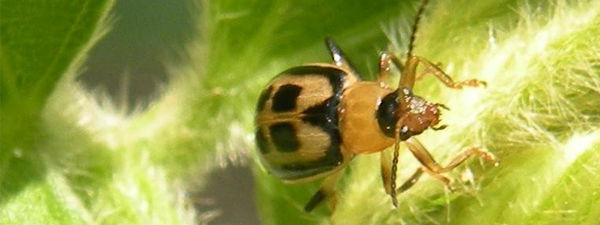Be Proactive to Fight Bean Leaf Beetle
September 4, 2019

The bean leaf beetle (Cerotoma trifurcata) ranks as one of the most significant soybean insect pests in the U.S. This beetle possesses the ability to attack foliage, pods and seeds. When adult bean leaf beetles feed on soybean plants, they can also transmit soybean diseases such as Bean Pod Mottle Virus (BPMV) disease, cowpea chlorotic mottle and southern bean mosaic virus.
Identification and lifecycle
Bean leaf beetle adults are about one-fourth inch long and usually yellow, tan or red in color. This beetle can be identified by a distinct black triangular mark on its wing covers directly behind the neck area. Often two black spots appear on each wing cover, and a distinct black band surrounds the outer edge. When disturbed, the bean leaf beetle folds its legs and falls to the ground, where it may remain motionless for a while.
The bean leaf beetle larva looks practically the same as corn rootworm. The larva is white and segmented with a brown head and a brown hardened area at the back end of its body.
Bean leaf beetles typically produce two generations per season. The overwintering generation attacks emerging soybeans in the spring. The overwintering beetles lay eggs that produce the first generation, which usually emerges in late June and July. The first generation population usually peaks in the late vegetative or early reproductive soybean stages. It is the second generation adults that peak and feed during the pod-fill stage in late summer, when damage can be significant.
Crop damage
The bean leaf beetle feeds on soybean leaves and/or developing pods throughout most of the season, resulting in damage. While soybean plants can sustain more than 50 percent foliage damage, they can’t compensate for damage that occurs during the early-season reproductive growth stages, according to the University of Missouri.
Overwintering adults develop colonies during soybean emergence, feeding on the cotyledons, stems, unifoliate leaves and emerging trifoliolates. Soybean stand losses are possible at this early reproductive growth stage, making it important to control bean leaf beetles early in the growing season.
First- and second-generation beetles chew small, round holes in the soybean leaves during the growing season. When maturing leaves become less attractive to the beetles, the insects feed on green pods, leaving a thin membrane over the seed. As the pod matures, this membrane may develop cracks, allowing airborne pathogens to enter and cause discolored, moldy, shriveled and diseased beans.
Scouting
Early-season scouting is critical to protect against bean leaf beetle damage. When plants are small, it’s easier to detect beetles and determine if cotyledon or stem feeding is significantly harming soybean seedlings. Look for damage and numbers of beetles per plant in at least five areas of the field. Scan the field while walking from one site to the next. Look for patterns and variations across the field. If insects and damage are not easily identified, consult county Extension personnel or a pest identification guide.
Best Management Practices to Control Bean Leaf Beetles
In no-till or limited-till situations, bean leaf beetles may become established in the soil, overwinter and feed on newly-planted seedlings. For best results managing bean leaf beetles, remove existing crop residue and control weeds through tillage, a burndown herbicide and preplant residual herbicides.
Fields kept weed-free by cultivation or herbicides applied two to three weeks before planting help control bean leaf beetle infestations.
Season-long weed control helps prevent bean leaf beetles from causing crop damage and harming yields and will help improve the effectiveness of in-season insecticide treatments.
Seed treatments
Starting off with a good seed treatment is an excellent way to control insects and protect soybean plants above and below the ground. A seed treatment will help protect soybean seedlings against insects such as bean leaf beetles, which overwinter and colonize during plant emergence.
Insecticides
Baythroid® XL, a pyrethroid, performs on a broad spectrum of insect pests with fast knockdown and long residual control. Baythroid XL may be used throughout the growing season; however, application timing should be based on careful scouting and local economic thresholds.
Another option growers have to control bean leaf beetles is Leverage® 360 with Stress Shield™ protection, which enhances the crop’s ability to handle a variety of biotic and abiotic stresses, thereby helping maximize yields. Unlike many other insecticides, Leverage 360 moves in a way that allows it to reach the underside of the leaves. It also safeguards plants from environmental stresses and can be applied in a tankmix with a fungicide.
To learn more about insect control options in soybeans, including Baythroid XL and Leverage 360, contact your local Bayer representative or talk with your local retailer.
*Always read and follow label instructions. Not all products are registered for use in every state. Baythroid XL and Leverage 360 are Restricted Use Pesticides.